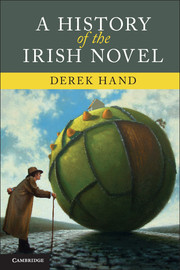Book contents
- Frontmatter
- Contents
- Acknowledgements
- Introduction A history of the Irish novel, 1665–2010
- Interchapter 1 Virtue Rewarded; or, the Irish Princess
- Chapter 1 Beginnings and endings
- Interchapter 2 Beyond history
- Chapter 2 Speak not my name; or, the wings of Minerva
- Interchapter 3 Edith Somerville and Martin Ross's The Real Charlotte
- Chapter 3 Living in a time of epic
- Interchapter 4 James Joyce's Ulysses
- Chapter 4 Irish independence and the bureaucratic imagination, 1922–39
- Interchapter 5 Elizabeth Bowen's The Last September and the art of betrayal
- Chapter 5 Enervated island – isolated Ireland? 1940–60
- Interchapter 6 John Banville's Doctor Copernicus: a revolution in the head
- Chapter 6 The struggle of making it new, 1960–79
- Interchapter 7 Seamus Deane's Reading in the Dark and the rebel act of interpretation
- Chapter 7 Brave new worlds
- Interchapter 8 John McGahern's That They May Face the Rising Sun
- Conclusion The future of the Irish novel in the global literary marketplace
- Notes
- Bibliography
- Index
Interchapter 7 - Seamus Deane's Reading in the Dark and the rebel act of interpretation
Published online by Cambridge University Press: 05 June 2012
- Frontmatter
- Contents
- Acknowledgements
- Introduction A history of the Irish novel, 1665–2010
- Interchapter 1 Virtue Rewarded; or, the Irish Princess
- Chapter 1 Beginnings and endings
- Interchapter 2 Beyond history
- Chapter 2 Speak not my name; or, the wings of Minerva
- Interchapter 3 Edith Somerville and Martin Ross's The Real Charlotte
- Chapter 3 Living in a time of epic
- Interchapter 4 James Joyce's Ulysses
- Chapter 4 Irish independence and the bureaucratic imagination, 1922–39
- Interchapter 5 Elizabeth Bowen's The Last September and the art of betrayal
- Chapter 5 Enervated island – isolated Ireland? 1940–60
- Interchapter 6 John Banville's Doctor Copernicus: a revolution in the head
- Chapter 6 The struggle of making it new, 1960–79
- Interchapter 7 Seamus Deane's Reading in the Dark and the rebel act of interpretation
- Chapter 7 Brave new worlds
- Interchapter 8 John McGahern's That They May Face the Rising Sun
- Conclusion The future of the Irish novel in the global literary marketplace
- Notes
- Bibliography
- Index
Summary
Remember me when I am gone away,
Gone far away into the silent land;
When you can no more hold me by the hand,
Nor I half turn to go yet turning stay.
(Christina Rossetti)Confusion is at the heart of Seamus Deane's (1940–) only novel, Reading in the Dark (1996). It hovers elusively between numerous narrative genres – the ghost story, detective fiction, the Gothic, and Bildungsroman – never finally settling on any single one. This uncertainty is central to the story itself with knowledge and knowing being the objects of desire in Deane's novel as his unnamed narrator searches for the truth at the heart of the secret that troublingly haunts his family. Amplifying this ambiguity is how Deane chooses to render his story through the conventions of the novel form and not as an autobiography or memoir, despite the story's genesis in reality and lived experience. In this manoeuvre, perhaps, can be discerned Deane's main preoccupation in Reading in the Dark; namely, a meditation on the nature not only of how stories are made but also the centrality of the act of reading and interpretation. In this latter concern, the author is being true to his day job as one of the pre-eminent literary critics of his generation. In a brilliant rethinking of the Irish scene, Deane recognises how debilitating the image of the stereotypical Irish person as artist figure has been in Irish writing: the figure who is the romantically sensitive type, the spendthrift with words, an unthinking poet who creates unknowingly, unthinkingly, leaving the important act of understanding and interpretation to others.
- Type
- Chapter
- Information
- A History of the Irish Novel , pp. 247 - 253Publisher: Cambridge University PressPrint publication year: 2011

